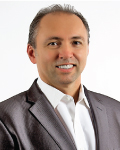Preventive Dentistry
One of the simplest dental hygiene exercises you can do for yourself is something you've heard before and it bears repeating: floss.
Every 24 hours, bacteria contribute to a new batch of plaque. Brushing, no matter how well done, will not get all the "bugs," especially between teeth and where tooth meets gum tissue. Flossing before or after brushing should be a part of everyone's oral health care program. The kind of floss, waxed, unwaxed, tape, doesn't matter. Just choose the product you're comfortable with, and use it.
Maybe you never quite got the hang of flossing, or are a little out of practice. Here's a quick refresher course.
- Wrap about 18 inches of floss around your fingers; give yourself about five to six taut inches to work with. If the floss frays or builds up with debris, re-loop the floss and keep at it.
- Try starting on the upper molars, way in the back; they're most difficult to reach. Follow the curve of enamel on every surface you can, three to four passes each.
- Where teeth meet, you may have to gently pull the floss to the gumline. Avoid sawing motions as that may damage soft tissue.
- Proceed from the back teeth to the center front. Then repeat the process on the other side.
- Rinse, and there you are.
If you find all this tedious or feel you're "all thumbs," a floss threader can help. Your dental hygienist can show you how to handle one. Just ask for help.
And remember, any amount of time you spend on plaque removal is time well spent for better dental health. The more time the better. If you have more questions or for more information, just call your dentist.
«« Back to Dental Information Center
Don't Forget to Floss!
Clean between teeth daily with floss or an interdental cleaner. Decay-causing bacteria can hide between teeth where toothbrush bristles can't reach. Flossing helps remove plaque and food particles from between teeth and under the gum line.
Visit Our Office Regularly!
Take good care of your smile. Remember to visit the dentist regularly for professional cleanings and oral exams.
Mouthwash Is Important, Too!
Brushing and flossing may not be enough. The ADA now recommends using an antimicrobial mouthwash to reduce plaque and prevent gingivitis.




